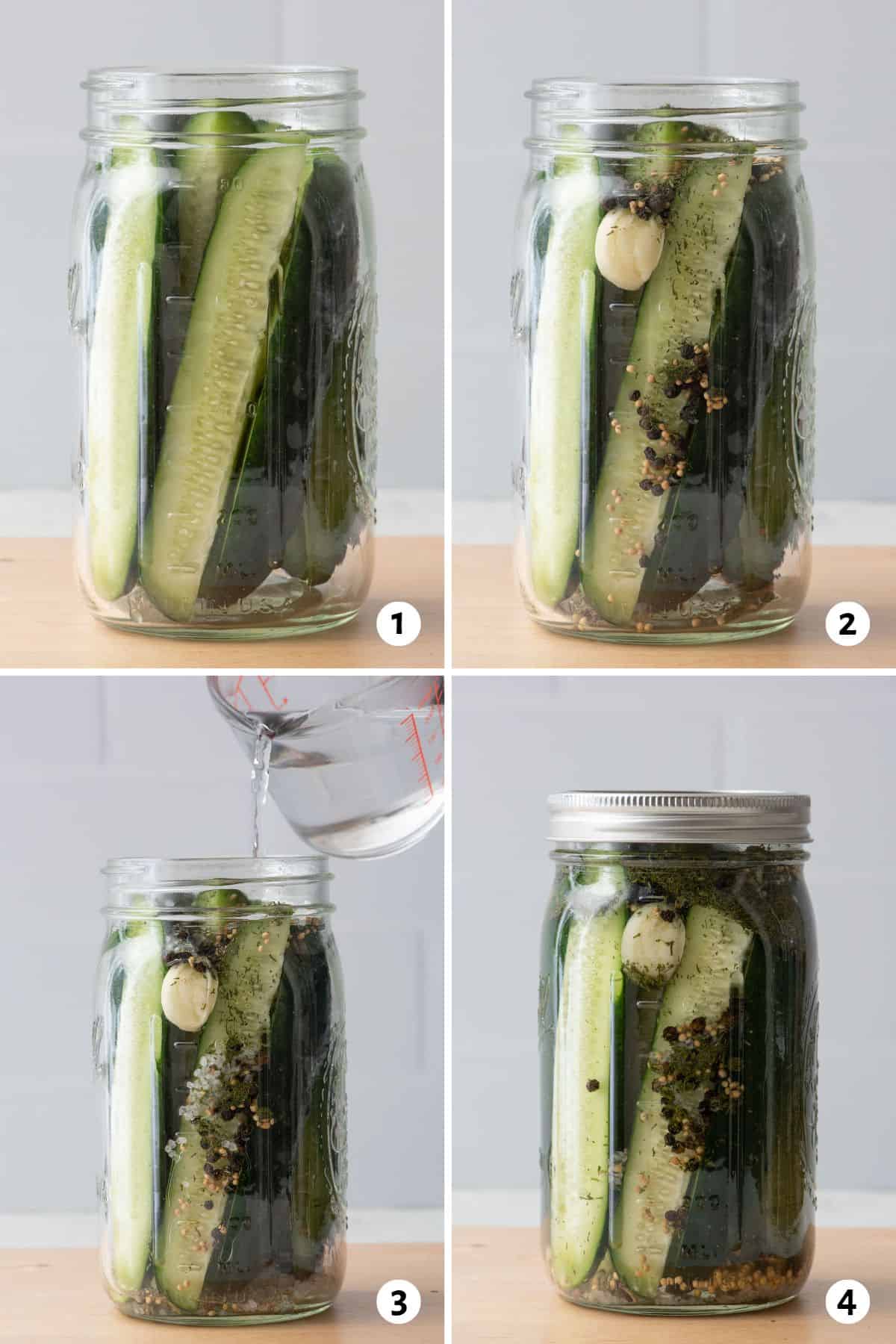How to Make Pickles
Published Jun 02, 2023
Learn how to make tangy, crunchy homemade pickles with this easy, quick pickling guide! Makes slices, spears, and whole dill pickles!
This post may contain affiliate links. Please read our disclosure policy.
Learn how to make pickles at home and say goodbye to store-bought ones! This pickle-making guide will lead you through a simple process, allowing you to enjoy your homemade pickles the very next day. Whether you prefer whole pickles, spears, or slices, this quick and easy recipe will become your go-to, with minimal ingredients and a short prep time. So stop buying store-bought and experience the satisfaction of quickly pickling cucumbers and savoring the deliciously tangy taste of homemade dill pickles.

Jump to Section
There’s nothing like learning how to make homemade pickles, especially when you realize how easy it is. And the timing is perfect, with an abundance of pickling cucumbers or gherkins available in the warmer months! These pickles are so delicious and crunchy that everyone will beg you for your secret recipe!
Why learn how to make your own pickles
- Flavor-control! Homemade pickles allow you to adjust the taste to how you like them. You can try various herbs, brines, and spices to create a unique and personalized flavor in each jar of pickles you make.
- Fresh and delicious. Say goodbye to store-bought pickles with their added preservatives and additives. Once you learn how to pickle cucumbers at home, you can make sure only the freshest and most wholesome ingredients are added.
- Save money. Making pickles at home can be a budget-friendly alternative to regularly buying jars from the store. You can pickle cucumbers when they are in season, when they are more affordable, helping you save money in the long run.
Ingredients to make dill pickles
- Pickling cucumbers: These are also called Kirby cucumbers and are the ideal choice for making pickles due to their mild flavor and satisfying crunch. You can also opt for the smaller variety known as gherkins for a sweeter pickle.
- Garlic: Fresh garlic is best and only needs to be peeled and smashed.
- Dill weed: Adding fresh dill not only brings a tangy flavor but also helps to balance and offset the sourness of the brine.
- Mustard seeds: Mustard seeds are added to enhance flavor, add texture, and act as a natural preservative.
- Black peppercorns: These add a spicy kick to the overall flavor of your pickles.
- Bay leaves: Including bay leaves, oak leaves, or grape leaves in fermented pickles is essential as their tannins help maintain the crispness and crunchiness for an extended period.
- White vinegar: Use distilled white vinegar because it has a neutral flavor and acidity to preserve the cucumbers without affecting their taste.
- Kosher salt: Kosher salt is best due to its pure, coarse texture and clean flavor.

How to make pickles at home
Grab a mason jar, a cutting board, and the rest of your ingredients to make the best homemade pickles!
Cut cucumbers for pickles
You can leave them whole or cut them into spears and slices, depending on what kind of pickles you want. You can use this zucchini-cutting tutorial as a guide on how to cut cucumbers for pickles.

Preparing pickles for brine
- Place the cucumbers into a jar.
- Add the garlic, dill, mustard seeds, pepper, and bay leaves.
- Bring the vinegar, water, and salt to a boil. Remove from heat and pour the brine over the pickles, covering them completely but leaving some space from the top.
- Tighten the lids securely and allow the jarred pickles to cool completely to room temperature.

Quick pickling
- Transfer the jars to the refrigerator.
- After 24 hours, your pickles should be ready!

Tips on how to pickle cucumbers quickly
- Make sure to trim the stem end of the cucumber. This contains enzymes that can affect how crispy the pickles get.
- Remove any air bubbles. If there’s too much air in the jar, it can prevent the jar from getting a good seal. Carefully tap the jars on the counter to make sure there are no air bubbles before sealing.
- Whole pickles may take a little longer. Because they are much larger, you may find it best to let them ferment longer than the sliced and speared pickles to be sure the brine penetrates completely through your cucumbers.
- For Longer Storage: First, bring a large pot of water to a boil and fully sterilize the jars and lids by submerging them in the boiling water. Once sterilized, dry them using a clean kitchen towel. After sealing the jars, place them back in a new pot of boiling water for 5 minutes to complete the canning process. As the jars cool, you will hear the canning lids pop down, indicating a proper seal. You can safely remove the jars from the boiling water at that point.

What to serve with the best dill pickles
- Grilled Turkey Burgers
- White Bean Avocado Sandwich
- Air Fryer Hamburgers
- Chickpea ‘Tuna’ Salad
- Lamb Burger
- Avocado Chicken Salad
How to store quick pickles
After adding the hot brine to your pickles, allow them to cool to room temperature. Then, transfer to the fridge to ferment overnight. Homemade pickles can be stored in the fridge until ready to eat!
How long will homemade pickles last in the fridge?
Store dill pickles in the fridge for up to 4 weeks or longer if you follow the long-term storage steps noted above and in the recipe card.
Can I freeze pickles?
Freezing is not advisable because its quality and crispness will deteriorate like other high-water content foods. The formation of ice crystals during freezing can break down the texture of the vegetable, resulting in a less desirable pickle. It is best to enjoy homemade pickles by storing them in the refrigerator rather than freezing them.
Frequently asked questions
You can create delicious pickles with just 3 ingredients – vinegar, salt, and water. Everything else that is added enhances their flavor and extends their shelf life.
For quick pickling, it is not necessary to boil the jars. If you want to preserve your pickles for a longer shelf life, then yes, you should boil the jars.
You activate and blend the flavors by heating the mixture of salt, water, and vinegar, resulting in a well-integrated and flavorful brine. This process also releases the herbs and spices’ aromatic properties, allowing them to penetrate and infuse the cucumbers for a delicious and flavorful bite.

Learning how to make pickles at home is a total win! You have total control over the ingredients and can enjoy the tangy and crispy crunch of homemade pickles without the added preservatives. This quick pickling recipe is perfect for last-minute BBQs, cookouts, or any meal that calls for a zesty dill pickle on the side.
More pickling recipes:
- How to Pickle Turnips
- How to Pickle Onions
- How to Make Beet Pickled Eggs
- How to Brine Chicken Tenders
If you try this feel good How to Make Pickles recipe or any other recipe on Feel Good Foodie, then don’t forget to rate the recipe and leave a comment below! It helps others who are thinking of making the recipe. We would love to hear about your experience making it. And if you snapped some shots, share it on Instagram so we can repost on Stories!

How to Make Pickles
Ingredients
- 4 pickling cucumbers
- 4 cloves garlic peeled and smashed
- 2 teaspoons dill weed
- 2 teaspoon mustard seeds
- 2 teaspoons whole black peppercorns
- 2 bay leaves crushed
- ½ cup white distilled vinegar
- ½ cup water
- 1 tablespoon kosher salt
Instructions
- Wash the mason jar in preparation for making refrigerator pickles or see notes for sterilizing for long term canning.
- Cut the cucumber into spears or slices or leave whole, as desired.
- Place the cucumbers into a 32-ounce jar. Add the garlic, dill, mustard seeds, pepper and bay leaves.
- Bring the vinegar, water and salt to a boil in a small saucepan over high heat. Remove from heat and pour the brine over the pickles, covering them completely and tightly, but making sure to leave about ½-inch of space from the top. Tighten the lids very securely.
- Allow the jars to cool completely to room temperature and their flavor will develop as they cool. Refrigerate for at least 24 hours before opening the jars. Keep stored in the refrigerator for up to 4 weeks.
Notes
Nutrition
Nutrition information provided is an estimate. It will vary based on cooking method and specific ingredients used.





